tires PONTIAC GRAND-AM 1993 Owners Manual
[x] Cancel search | Manufacturer: PONTIAC, Model Year: 1993, Model line: GRAND-AM, Model: PONTIAC GRAND-AM 1993Pages: 306, PDF Size: 15.39 MB
Page 130 of 306
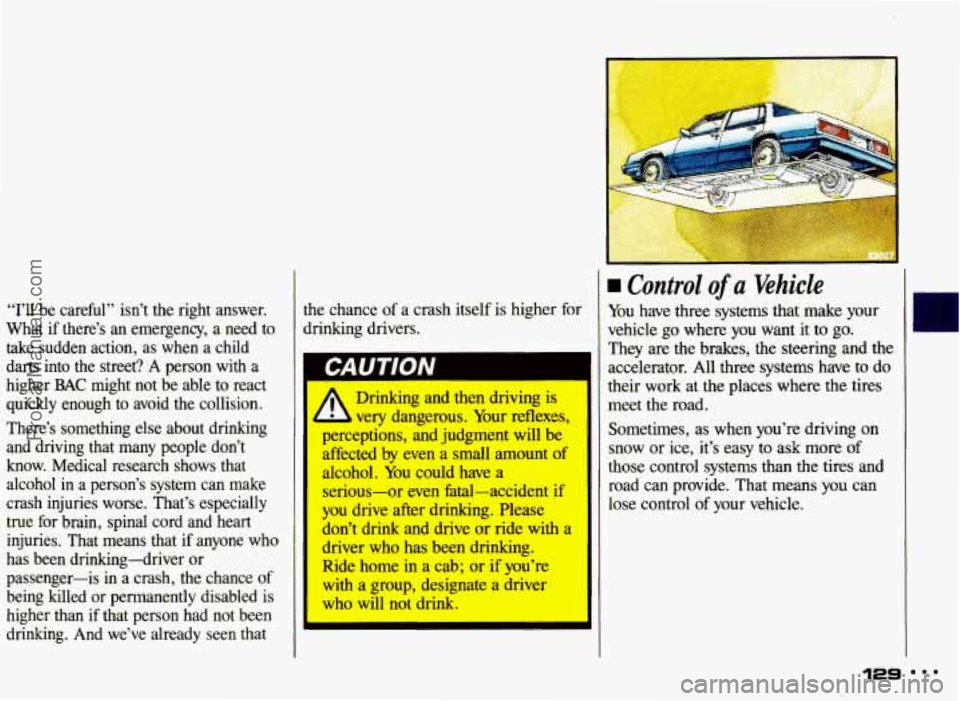
“I’ll be careful” isn’t the right answer.
What if there’s an emergency, a need to take sudden action, as when a child
darts into the street?
A person with a
higher
BAC might not be able to react
quickly enough to avoid the collision.
There’s something else about drinking
and driving that many people don’t
know. Medical research shows that
alcohol in a person’s system can make
crash injuries worse. That’s especially
true for brain, spinal cord and heart
injuries. That means that if anyone who
has been drinking-driver or
passenger-is in a crash, the chance of
being killed or permanently disabled is
higher than
if that person had not been
drinking. And we’ve already seen that the
chance of a crash itself is higher for
drinking drivers.
I
i Drinking and then driving is L b very dangerous. Your reflexes,
perceptions, and judgment will be
affected by even a small amount
of
alcohol. You could have a
serious-or even fatal-accident if
you drive after drinking. Please
don’t drink and drive or ride with a
driver who has been drinking.
Ride home in a cab; or if you’re
with a group, designate a driver
who will not drink.
I
rn Control of a Vehicle
You have three systems that make your
vehicle
go where you want it to go.
They are the brakes, the steering and the
accelerator. All three systems
have to do
their work at the places where the tires
meet the road.
Sometimes, as when you’re driving on
snow or ice, it’s easy to ask more of
those control systems than the tires and
road can provide. That means
you can
lose control of your vehicle.
ProCarManuals.com
Page 137 of 306
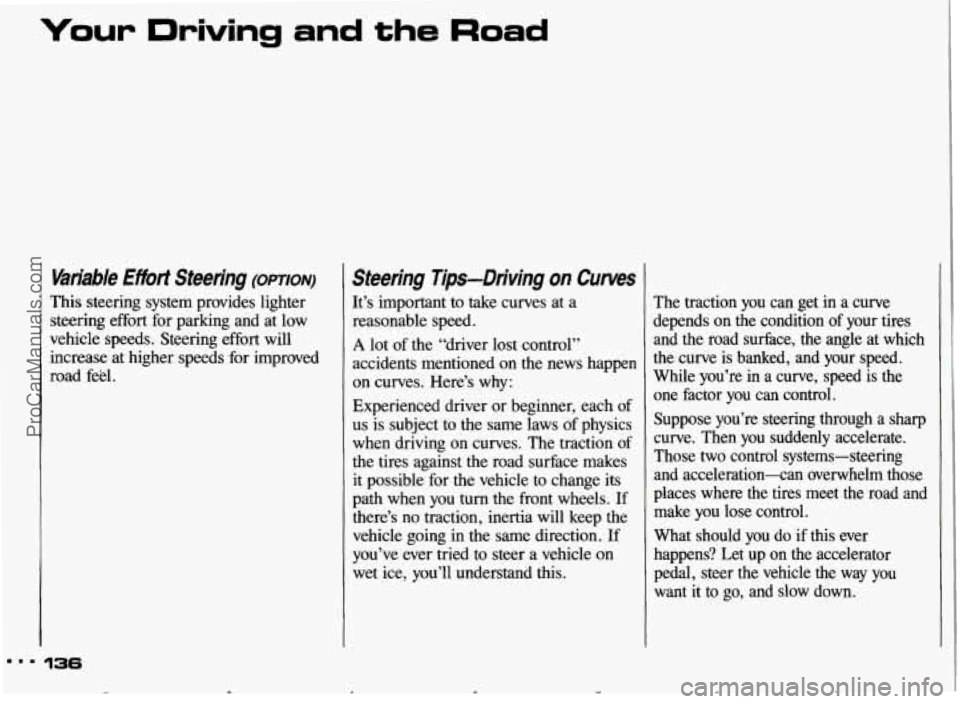
Your Driving and the Road
Variable Effort Steering (omoN)
This steering system provides lighter
steering effort for parking and at low
vehicle speeds. Steering effort will
increase at higher
speeds for improved
road feel.
Steering Tips-Driving on Curves
It’s important to take curves at a
reasonable speed.
A lot of the “driver lost control”
accidents mentioned on the
news happen
on curves. Here’s why:
Experienced driver or beginner, each
of
us is subject to the same laws of physics
when driving on curves. The traction of
the tires against the road surface makes
it possible for the vehicle to change its
path when you
turn the front wheels. If
there’s no traction, inertia will keep the
vehicle going in the same direction. If
you’ve ever tried to steer a vehicle on
wet ice, you’ll understand this. The traction
you
can get in a curve
depends on the condition of your tires
and the road surface, the angle at which
the curve is banked, and your speed.
While you’re
in a curve, speed is the
one factor you can control.
Suppose you’re steering through
a sharp
curve. Then you suddenly accelerate. Those
two control systems-steering
and acceleration-can overwhelm those
places where the tires meet the road and make you lose control.
What should you do if this ever
happens? Let up on the accelerator
pedal, steer the vehicle the way you
want it to go, and slow down.
8.8 136
ProCarManuals.com
Page 141 of 306
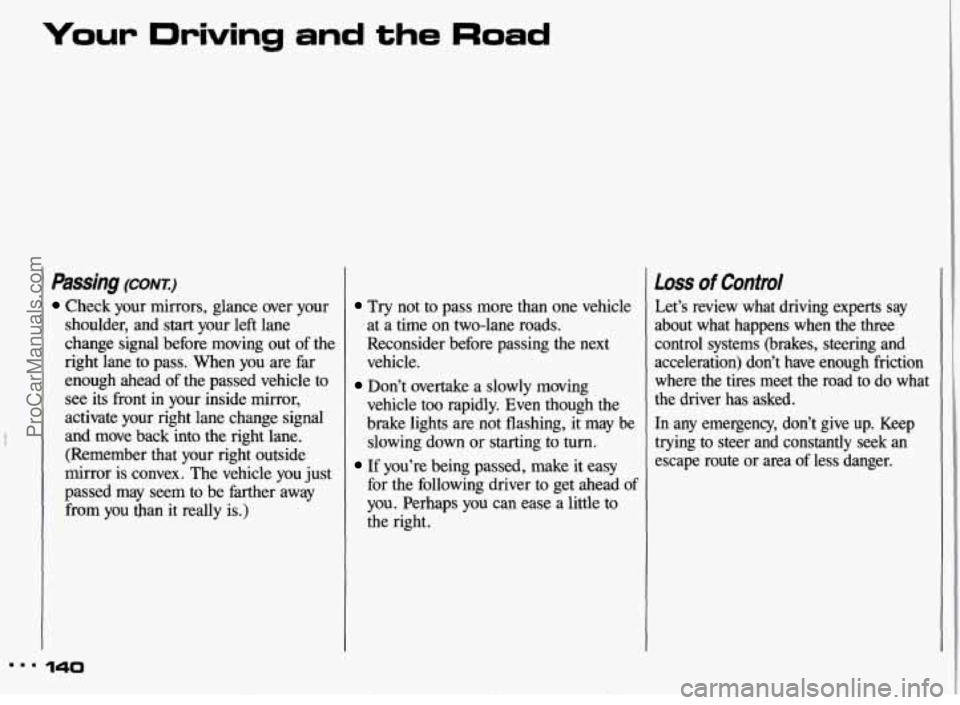
Your Driving and the Road
Passing (CONT.)
Check your mirrors, glance over your
shoulder, and
start your left lane
change signal before moving out of the
right lane to pass. When you are far
enough ahead of the passed vehicle to
see its front in your inside mirror,
activate your right lane change signal
and move back into the right lane.
(Remember that your right outside
mirror
is convex. The vehicle you just
passed may seem to be farther away
from
you than it really is.)
140
Try not to pass more than one vehicle
at a time on two-lane roads.
Reconsider before passing the next
vehicle.
vehicle too rapidly. Even though the
brake lights are not flashing, it may be
slowing down
or starting to turn.
If you’re being passed, make it easy
for the following driver to get ahead of
you. Perhaps you can ease a little to
the right.
Don’t overtake a slowly moving
Loss of Control
Let’s review what driving experts say
about what happens when the three
control systems (brakes, steering and
acceleration) don’t have enough friction
where the tires meet the road to do what
the driver has asked.
In any emergency, don’t give up. Keep
trying to steer and constantly seek an
escape route or area
of less danger.
ProCarManuals.com
Page 142 of 306
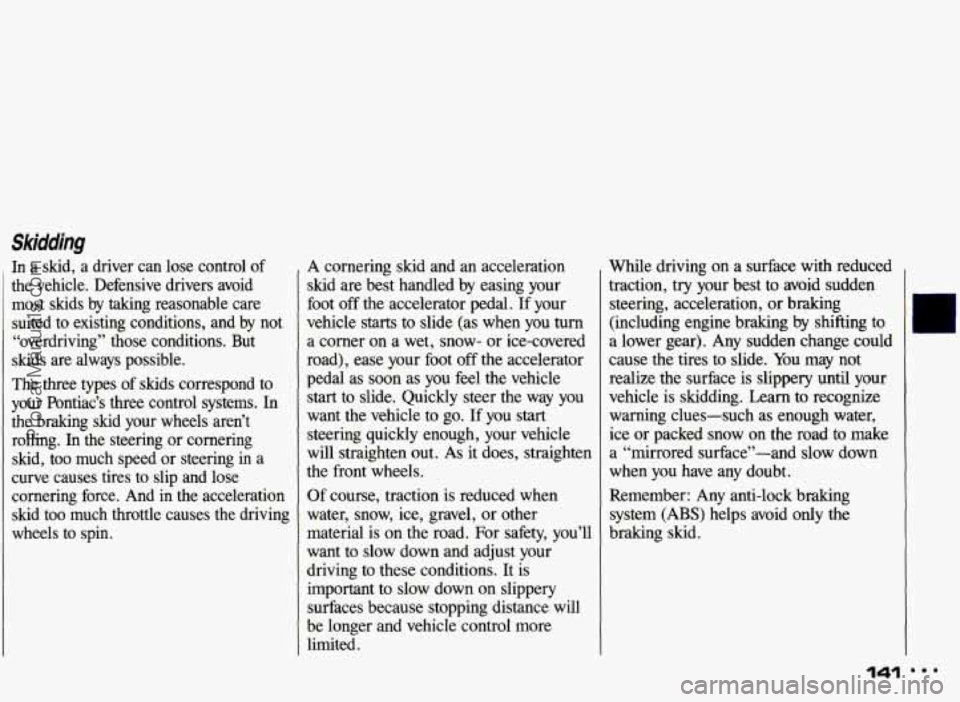
Skidding
In a skid, a driver can lose control of
the vehicle. Defensive drivers avoid
most skids by taking reasonable care
suited to existing conditions, and by not
“overdriving” those conditions. But
skids are always possible.
The three types of skids correspond to
your Pontiac’s three control systems.
In
the braking skid your wheels aren’t
rolling.
In the steering or cornering
skid, too much speed or steering in a
curve causes tires to slip and lose cornering force. And in the acceleration
skid too much throttle causes the driving
wheels to spin. A
cornering skid and an acceleration
skid are best handled by easing your
foot
off the accelerator pedal. If your
vehicle starts to slide (as when you turn
a corner on a wet, snow- or ice-covered
road), ease your foot off the accelerator
pedal as soon as you feel the vehicle
start to slide. Quickly steer the way you
want the vehicle to go.
If you start
steering quickly enough, your vehicle
will straighten out. As it does, straighten
the front wheels.
Of course, traction is reduced when
water, snow, ice, gravel, or other
material is on the road. For safety, you’ll
want to slow down and adjust your
driving to these conditions. It is
important to slow down on slippery surfaces because stopping distance will
be longer and vehicle control more
limited. While driving on
a surface with reduced
traction, try your best to avoid sudden
steering, acceleration, or braking
(including engine braking by shifting to
a lower gear). Any sudden change could
cause the tires to slide.
You may not
realize the surface is slippery until your
vehicle is skidding. Learn to recognize
warning clues-such as enough water,
ice or packed snow
on the road to make
a “mirrored surface”-and slow down
when you have any doubt.
Remember: Any anti-lock braking
system
(ABS) helps avoid only the
braking skid.
141
ProCarManuals.com
Page 145 of 306
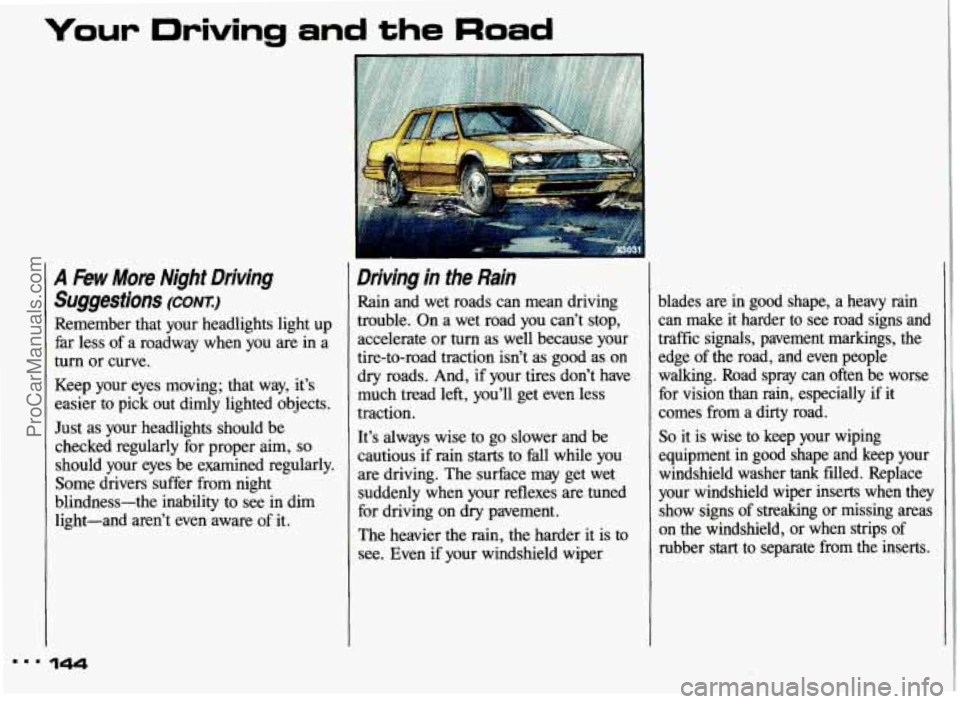
Your Driving and the Road
A &w More Night Driving
Suggestions
(CONTJ
Remember that your headlights light up
far
less of a roadway when you are in a
turn or curve.
Keep your eyes moving; that way,
it’s
easier to pick out dimly lighted objects.
Just as your headlights should be
checked regularly for proper aim,
so
should your eyes be examined regularly.
Some drivers suffer from night
blindness-the inability to see
in dim
light-and aren’t even aware
of it.
144
Driving in the Rain
Rain and wet roads can mean driving
trouble. On a wet road you can’t stop,
accelerate or
turn as well because your
tire-to-road traction isn’t as good
as on
dry roads.
And, if your tires don’t have
much tread left, you’ll get even less
traction.
It’s always wise to go slower and be
cautious
if rain starts to fall while you
are driving. The surface may get wet
suddenly when your reflexes are tuned
for driving on
dry pavement.
The heavier the
rain, the harder it is to
see. Even if your windshield wiper blades are in good shape, a heavy rain
can make it harder to see road signs and
traffic signals, pavement markings, the edge of the road, and even people
walking. Road spray can often be worse for vision than rain, especially
if it
comes from
a dirty road.
So it is wise to keep your wiping
equipment in
good shape and keep your
windshield washer
tank fdled. Replace
your windshield wiper inserts when they show signs of streaking or missing areas
on the windshield, or when strips of
rubber
start to separate from the inserts.
ProCarManuals.com
Page 146 of 306
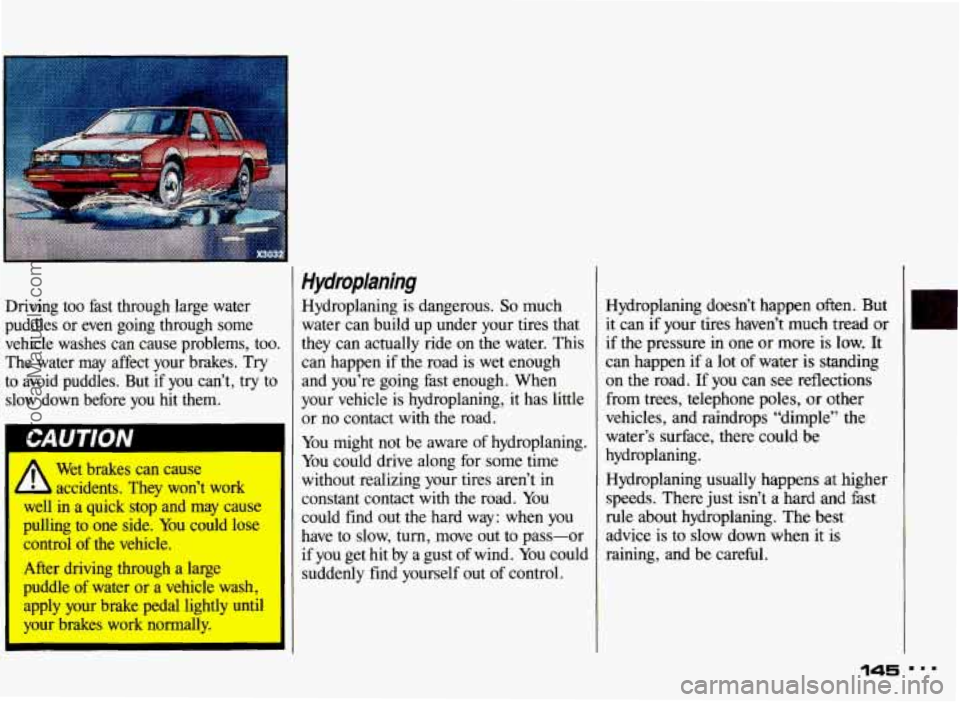
Driving too fast through Parge water
puddles or even going through some
vehicle washes can cause problems, toc The water may affect your brakes.
Try
to avoid puddles. But if you can’t, try to
slow down before you hit them.
t.
I
1 CAUTION I
Wet brakes can cause
accidents. They won’t work
dl in a quick stop and may cause
pulling to one side. You could lose
control of the vehicle.
After driving through a large
puddle of water or a vehicle wash,
apply your brake pedal lightly until
your brakes work normally.
Hydroplaning
Hydroplaning is dangerous. So much
water can build up under your tires that
they can actually ride on the water. This
can happen if the road is wet enough
and you’re going fast enough. When
your vehicle is hydroplaning, it has little
or no contact with the road.
You might not be aware
of hydroplaning.
You could drive along for some time
without realizing your tires aren’t in
constant contact with the road. You
could find out the hard way: when you
have to slow, turn, move out to pass-or
if you get hit by a gust
of wind. You could
suddenly find yourself out of control. Hydroplaning doesn’t
happen often. But
it can if your tires haven’t much tread
or
if the pressure in one or more is low. It
can happen if a lot of water is standing
on the road. If you can
see reflections
from trees, telephone poles, or other
vehicles, and raindrops “dimple” the
water’s surface, there could
be
hydroplaning.
Hydroplaning usually happens at higher
speeds. There just isn’t
a hard and fast
rule about hydroplaning. The best
advice is to slow down when it
is
raining, and be careful.
145 ’
ProCarManuals.com
Page 147 of 306
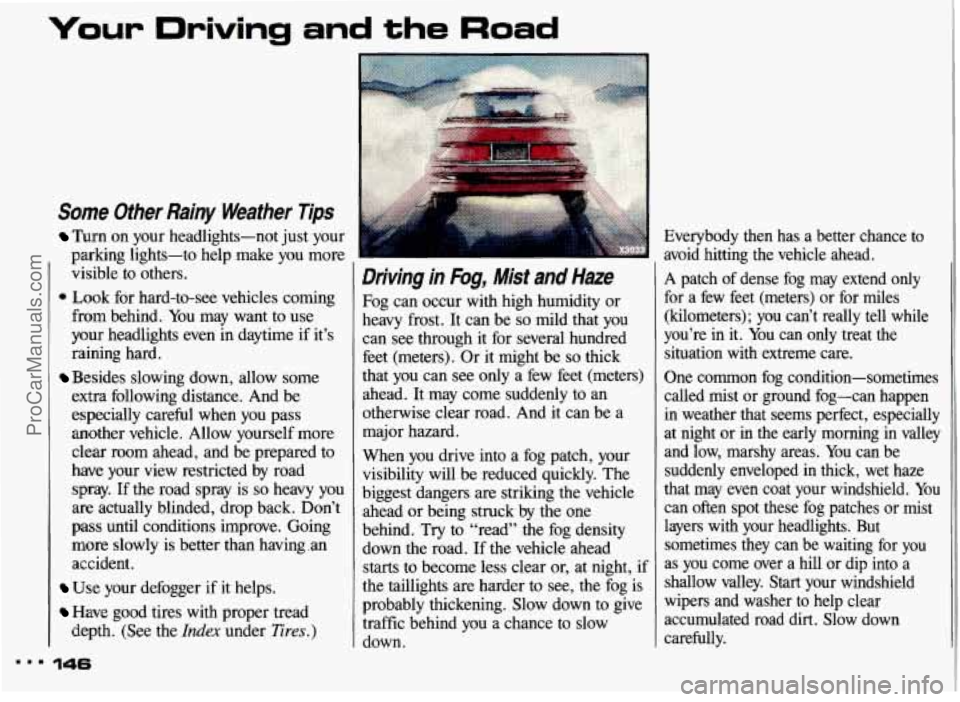
Your Driving and the Road
Some Other Rainy Weather Tips
Turn on your headlights-not just your
parking lights-to help make you more
visible to others.
* Look for hard-to-see vehicles coming
from behind. You may want to use
your headlights even in daytime
if it’s
raining hard.
Besides slowing down, allow some
extra following distance. And be
especially careful when you pass
another vehicle. Allow yourself more
clear room ahead, and be prepared
to
have your view restricted by road
spray. If the road spray is
so heavy you
are actually blinded, drop back. Don’t
pass until conditions improve. Going
more slowly is better than having an
accident.
Use your defogger if it helps.
Have good tires with proper tread
depth. (See
the Index under Tires.)
Driving in Fog, Mist and Haze
Fog can occur with high humidity or
heavy frost. It can be
so mild that you
can see through it for several hundred
feet (meters). Or it might be
so thick
that you can see only a few feet (meters)
ahead.
It may come suddenly to an
otherwise clear road. And it can be a
major hazard.
When you drive into a fog patch, your
visibility will be reduced quickly. The
biggest dangers are striking the vehicle
ahead or being struck by the one
behind.
Try to “read’’ the fog density
down the road. If the vehicle ahead
starts
to become less clear or, at night, if
the taillights are harder to see, the fog is
probably thickening. Slow down to give
traffic behind you a chance to slow
down. Everybody then has a better chance
to
avoid hitting the vehicle ahead.
A patch of dense fog may extend only
for a few feet (meters)
or for miles
(kilometers); you can’t really tell while
you’re
in it. You can only treat the
situation with extreme care.
One common fog condition-sometimes called mist or ground fog-can happen
in weather that seems perfect, especially
at night or in the early morning
in valley
and low, marshy areas. You can be
suddenly enveloped in thick, wet haze
that may even coat your windshield. You
can often spot these fog patches or mist
layers with your headlights.
But
sometimes they can be waiting for you
as you come over a hill or dip into a
shallow valley. Start your windshield
wipers and washer to help clear
accumulated road dirt. Slow down
carefully.
... 146
ProCarManuals.com
Page 152 of 306
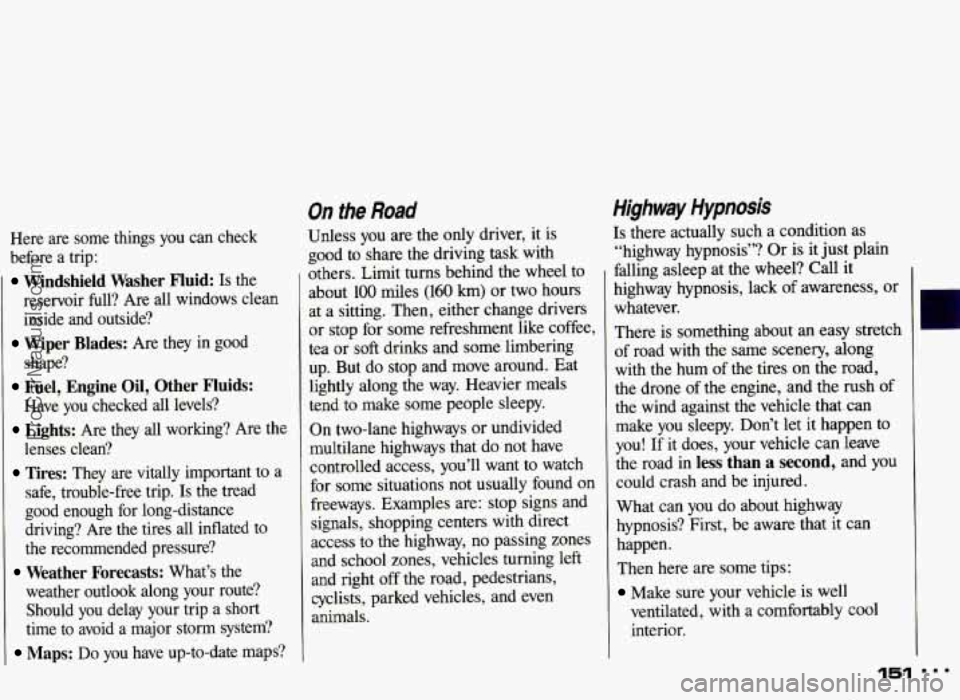
Here are some things you can check
before a trip:
Windshield Washer Fluid: Is the
reservoir full? Are all windows clean
inside and outside?
shape?
Have you checked all levels?
lenses clean?
safe, trouble-free trip.
Is the tread
good enough for long-distance
driving? Are the tires all inflated to
the recommended pressure?
weather outlook along your route? Should you delay your trip a short
time to avoid a major storm system?
Maps: Do you have up-to-date maps?
Wiper Blades: Are they in good
Fuel, Engine Oil, Other Fluids:
Lights: Are they all working? Are the
Tires: They are vitally important to a
Weather Forecasts: What’s the
On the Road
Unless you are the only driver, it is
good to share the driving task with
others. Limit
turns behind the wheel to
about
100 miles (160 km) or two hours
at a sitting. Then, either change drivers
or stop for some refreshment like coffee,
tea or
soft drinks and some. limbering
up. But do stop and move around. Eat
lightly along the way. Heavier meals
tend to make some people sleepy.
On two-lane highways or undivided
multilane highways that do not have
controlled access, you’ll want to watch
for some situations not usually found on
freeways. Examples are: stop signs and
signals, shopping centers with direct
access to the highway, no passing zones
and school zones, vehicles turning left
and right off the road, pedestrians,
cyclists, parked vehicles, and even
animals.
Highway Hypnosis
Is there actually such a condition as
“highway hypnosis”? Or is it just plain
falling asleep at the wheel?
Call it
highway hypnosis, lack of awareness, or
whatever.
There is something about an easy stretch
of road with the same scenery, along
with the hum of the tires on the road,
the drone of the engine, and the rush
of
the wind against the vehicle that can
make you sleepy. Don’t let it happen
to
you! If it does, your vehicle can leave
the road
in less than a second, and you
could crash and be injured.
What can you do about highway
hypnosis? First, be aware that it can
happen.
Then here are some tips:
Make sure your vehicle is well
ventilated, with a comfortably cool
interior.
151 ...
ProCarManuals.com
Page 153 of 306
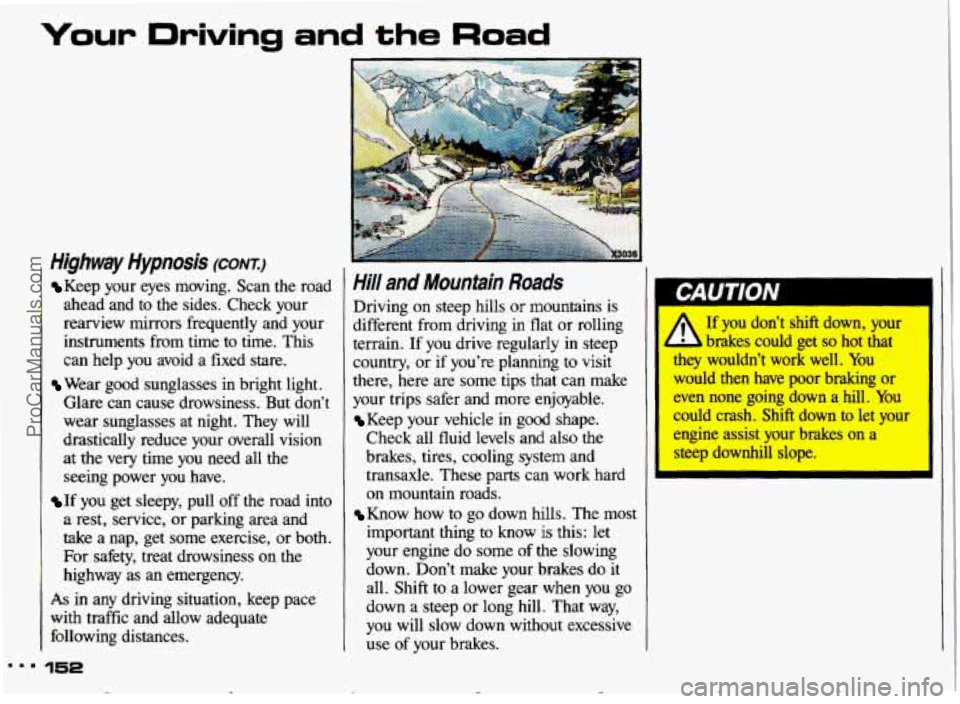
your urwlng and the Road
Highway Hypnosis (CONI)
Keep your eyes moving. Scan the road
ahead and to the sides. Check your
rearview mirrors frequently and your
instruments from time to time. This
can help you avoid a fixed stare.
Wear good sunglasses in bright light.
Glare can cause drowsiness. But don’t
wear sunglasses at night. They will
drastically reduce your overall vision
at the very time you need all the
seeing power you have.
If you get sleepy, pull off the road into
a rest, service, or parking area and
take a nap, get some exercise, or both.
For safety, treat drowsiness on the
highway as an emergency.
As in any driving situation, keep pace
with traffic and allow adequate
following distances.
I CAUTION
d
Hill and Mountain Roads
Driving on steep hills or mountains is
different from driving in flat or rolling
terrain. If
you drive regularly in steep
country, or
if you’re planning to visit
there, here are
some tips that can make
your trips safer and more enjoyable.
Keep your vehicle in good shape.
Check all fluid levels and also the
brakes, tires, cooling system and
transaxle. These parts can work hard
on mountain roads.
Know how to go down hills. The most
important thing to know
is this: let
your engine do some of the slowing
down. Don’t make your brakes
do it
all. Shift to a lower gear when
you go
down a steep or long hill. That way,
you will slow down without excessive
use of your brakes.
A
If you don’t shift down, your
brakes could get
so hot that
they wouldn’t work well.
You
would then have poor braking or
even none going down a hill. You
could crash. Shift down to let your
engine assist your brakes on
a
steep downhill slope.
ProCarManuals.com
Page 155 of 306
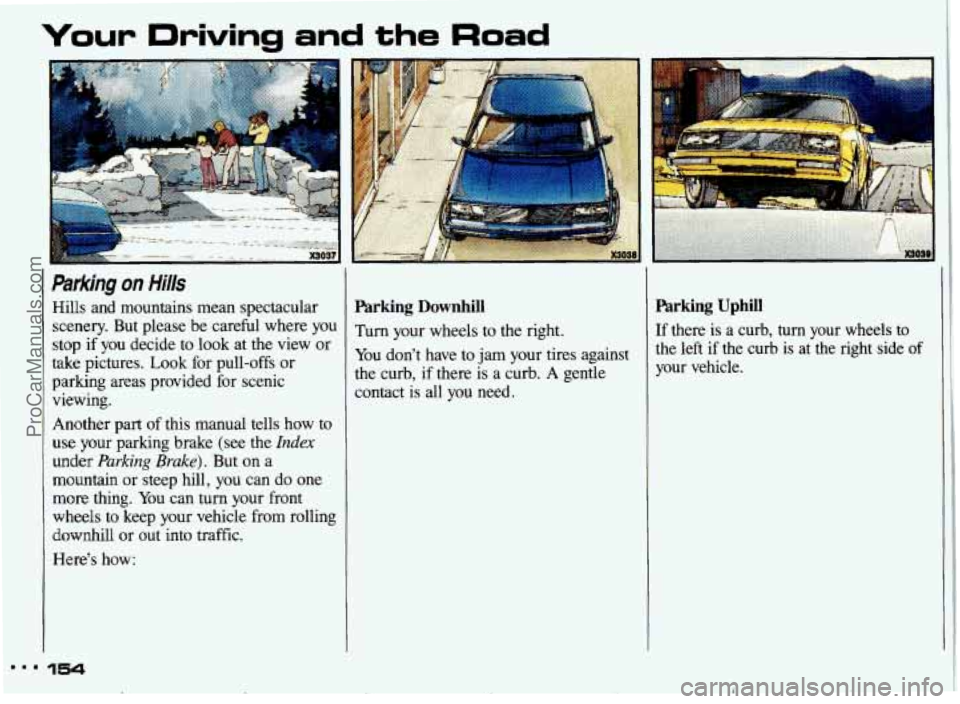
Your Driving and the Road
parking on Hills
Hills and mountains mean spectacular
scenery. But please be careful where you
stop if you decide to look at the view or
take pictures. Look for pull-offs or
parking areas provided for scenic
viewing.
Another part
of this manual tells how to
use your parking brake (see the
Index
under Parking Brake). But on a
mountain or steep hill, you can do one
more thing. You can turn your front
wheels to keep your vehicle from rolling
downhill or out into traffic.
Here's how:
Parking Downhill
Turn your wheels to the right.
You don't have to jam your tires against
the curb, if there is
a curb. A gentle
contact is all you need.
Parking Uphill
If there is a curb, turn your wheels to
the left if the curb is at the right side of
your vehicle.
ProCarManuals.com